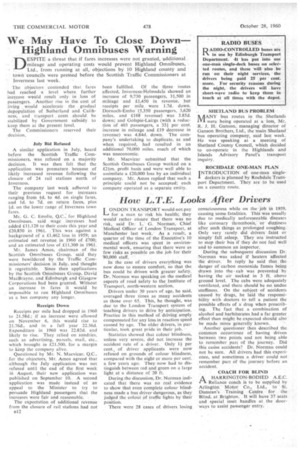How L.T.E. Loo ks After Drivers
Page 46

If you've noticed an error in this article please click here to report it so we can fix it.
ON DON TRANSPORT would not pay 1--4 for a man to risk his health; they would rather ensure that there was no • risk, said Dr. L.'. G. Norman, Chief -Medical Officer of London Transport, at -Manchester last week.' As a result, a quarter of the time of the Executive's 10 medical officers was spent in envirOnmental work, ensuring that there were as few risks as possible on the job for their '80,000 staff.
In the case of drivers everything was now done to ensure comfort, so that the bus could be driven with greater Safety. Dr. Norman was speaking on the medical aspects of road safety to the Institute of Transport, north-western section.
Drivers under 30 years of age, he said, averaged three times as many accidents as those over 65. This, he thought, was due to the London Transport system of teaching drivers to drive by anticipation. Practice in this 'method of driving amply compensated for any loss in reaction speed caused by age. The older drivers, in particular, took great pride in their job.
Statistics showed that colour blindness, unless very severe, did not increase the accident rate of a driver. Only 1+ per cent.. of driver applicants were now refused on grounds of colour blindness, compared with the eight or more per cent. a few years ago. They.now had to distinguish between red'and green on a large light at a distance of 20 ft.
During the discussion, Dr. Norman indicated that there was no real evidence to show that even complete colour blindness made a bus driver dangerous, as they judged the colour Of traffic lights by their position.
There were 28 eases of drivers losing
consciousness while on the job in 1959, causing some fatalities. This was usually due to medically unforeseeable diseases like coronary thrombosis, or dizziness after such things as prolonged coughing. Only very rarely did drivers faint or simply fall asleep. They are instructed to stop their bus if they do not feel well and tO summon an inspector.
During the subsequent discussion Dr. -Norman was asked if heaters affected the driver. In reply he said that the danger of carbon monoxide fumes being drawn into thecab •was prevented by having the air sucked in 3 ft. above ground level. The cabs were adequately ventilated, and there should be no undue stuffiness. On the subject, of accidents caused by drugs, he laid the responsibility with doctors to tell a patient the possible effects of a drug when prescribing. The fact that a combination of alcohol and barbiturates had a far greater .effect than might be expected should also be made more generally known.
Another questioner then described the common occurrence of having driven between two points and not being able to remember part of the journey. Did this cause accidents? Dr. Norman could not be sure. All drivers had this experience, and sometimes a driver could not remember part of the journey before an accident.
COACH FOR BLIND
A HARRINGTON-BODIED A.E.C. rt Reliance coach is to be supplied by Arlington Motor Co., Ltd., to St. Dunstan's Training Centre for the Blind, at Brighton. It will have 37 seats and special inset handles at the door'ways to assist passenger entry.




















































































































